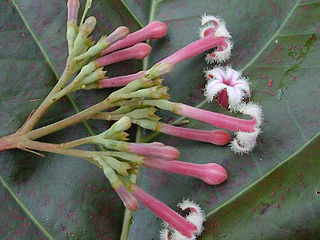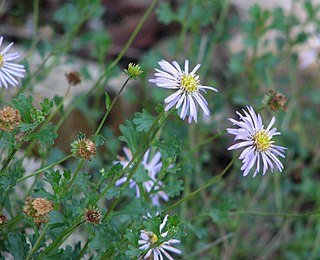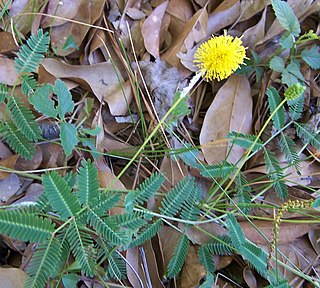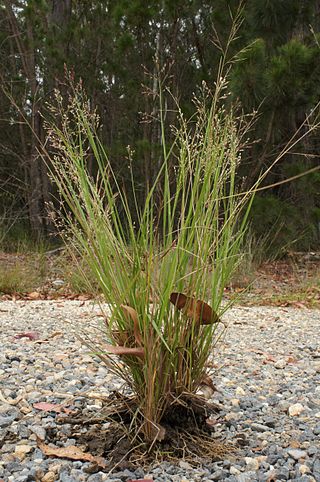
Karel Domin was a Czech botanist and politician.

Petalostigma is a genus of plants under the family Picrodendraceae and the monogeneric subtribe Petalostigmatinae, first defined by von Mueller in 1857. It is native to New Guinea and Australia. They are evergreen, dioecious shrubs or trees.

Acacia inaequilatera, commonly known as kanji bush, baderi, camel bush, fire wattle, kanyji bush or ranji bush is a tree in the family Mimosaceae. Endemic to Australia, it is widely distributed in the semi-arid Triodia country eastwards from Karratha, Western Australia into the Northern Territory.

Solanum ellipticum is known as potato bush and under the more ambiguous name of "bush tomato". The Arrernte name of merne awele-awele might refer to this species or to the similar S. quadriloculatum. Native to Australia, the potato bush is a small fruiting shrub in the family Solanaceae.

Cinchona pubescens, also known as red cinchona and quina (Kina), is native to Central and South America. It is known as a medicinal plant for its bark's high quinine content- and has similar uses to C. officinalis in the production of quinine, most famously used for treatment of malaria.

Stackhousia is a genus of annual and perennial plants in the family Celastraceae that are native to Australia, New Zealand, Malesia and Micronesia. The genus was first described by James Edward Smith in Transactions of the Linnean Society of London in 1798.

Calotis is a genus of herbs or small shrubs in the daisy family Asteraceae. Most of the species are native to Australia, while two occur in Asia.

Ficus pantoniana, commonly known as the climbing fig, is a plant in the fig family Moraceae. It is native to the eastern part of Malesia, Papua New Guinea, and northeastern Queensland. It is a woody root climber which may reach 6 m in height. It was described by botanist George King in 1887 from a specimen collected in New Guinea. Ficus nugenti by Karel Domin in 1921, and F. scandens var. australis by Bailey are synonyms.

Neptunia is a genus of flowering plants in the family Fabaceae. It belongs to the mimosoid clade of the subfamily Caesalpinioideae.
Notochloe is a genus of Australian plants in the grass family.
Sida clementii is a shrub in the family Malvaceae, native to Western Australia. It has an erect, spreading habit and grows to between 0.4 and 1.3 metres high. Yellow flowers are produced between March and May and again between September and November in the species' native range on plains in the Pilbara.

Convolvulus clementii, commonly known as desert bindweed, is a trailing perennial plant species, native to inland Australia. Mostly found on flat areas, like dune swales and claypans that are subject to seasonal inundation, in areas of open grassy woodland.
Triumfetta clementii is a shrub species that occurs in the north-west of Western Australia. It has an erect, spreading habit, growing to between 0.15 and 0.6 metres high. Yellow flowers appear between May and October in the species' native range.

Acacia cognata, commonly known as bower wattle, river wattle or narrow-leaved bower wattle, is a tree or shrub species that is endemic to south eastern Australia.

Lomatia myricoides, commonly known as the river lomatia, is a shrub native to New South Wales and Victoria in southeastern Australia.

Acacia argyrodendron, known colloquially as black gidyea or blackwood, is a species of Acacia native to Australia. Czech botanist Karel Domin described this species in 1926 and it still bears its original name. Domin reported collecting the type specimen from somewhere between Camooweal and Burketown in northwestern Queensland, though it is more likely to have been northeast of Aramac.

Persoonia adenantha is a plant in the family Proteaceae and is endemic to eastern Australia. It is an upright shrub or small tree with smooth, elliptic to lance-shaped leaves and groups of hairy yellow flowers. It has sometimes been confused with P. cornifolia and P. stradbrokensis.

Panicum simile, known by the common name two colour panic, is a species of grass found in eastern Australia. It was described by Karel Domin in 1915.

Seringia is a genus of about 18 species of plants in the family Malvaceae. Species of Seringia are native to Australia, New Guinea, and Madagascar. They are small shrubs with soft silken leaves. The flowers are purple or mauve and appear in profusion. The calyx is the most conspicuous part of the flower.

Nicotiana rustica is a plant in the family Solanaceae, native to Western Australia, South Australia and the Northern Territory.

















